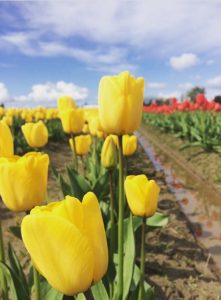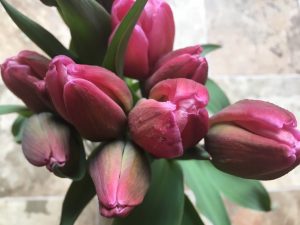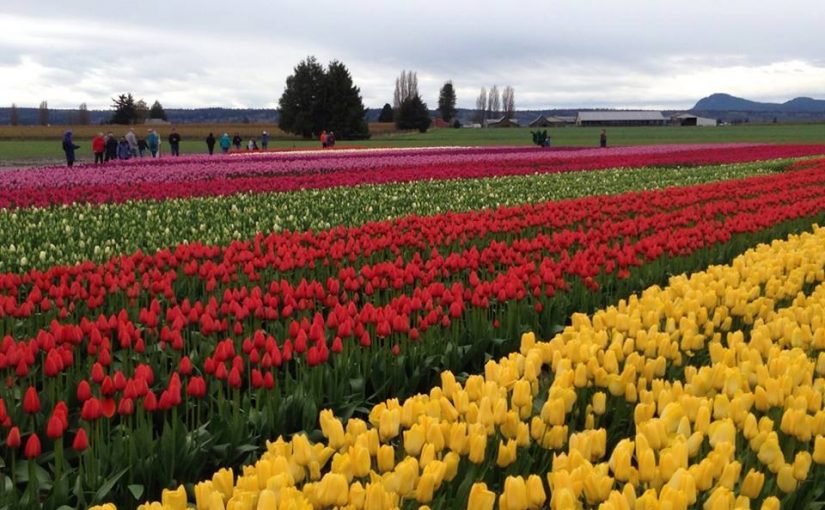Family: Liliaceae (also in this family: lilies, trillium, star-of-Bethlehem). Members of this family are monocotyledonous, perennial, herbaceous and often bulbous geophytes. Plants in this family have evolved with a fair amount of form/structural diversity despite genetic similarity (Bayton & Maughan) (Zomlefer).

Photo: Allie Kuppenbender
Subfamily: Ericoideae
Tribe: Lilieae
Genus: Tulipa
Scientific Name: Tulipa gesneriana (common garden tulip)
Tulips are an incredibly popular early spring flower, especially in the Pacific North West. The Skagit River Valley of western Washington state is the largest producer of tulips in the world, actually surpassing Dutch tulip production! The Dutch are very well known for tulip production in the past and present. The obvious example is the Tulip Mania of the 1630s, with the speculative bubble bursting in 1637. During this period, tulip bulbs were selling for astronomical sums of money, with the most expensive (known by its cultivar name “Viceroy”) selling for between 3,000-4,200 florins (size dependent). For comparison, a skilled craftsperson made roughly 300 florins annually! (Botany of Desire)
Michael Pollan, in his book-turned-documentary Botany of Desire, outlines four crops (apples, tulips, potatoes, and marijuana) and how they interact and evolve in conjunction with humans. Within the tulip section, Pollan breaks down how tulips captivate humans. “The tulip has merely done what any flower does:: evolve alongside a particular culture’s (or for that matter, animal’s) ideal of beauty. Embedded in the genes of every tulip is the blueprint for what will captivate a bumblebee or a hummingbird, a Dutchman or an Ottoman Turk” (Botany of Desire).
Native to the mountains of Central Asia, tulips were brought across Asia to Turkey to Europe by humans, slowly being selectively bred for various colors, sizes, and shapes.
Tulips are perennials; the bulb allows the plant to overwinter and bloom year to year. Most cut-flower growers however treat tulips as an annual as cutting the flower impacts the bloom quality. According to Mandy O’Shea of 3 Porch Farms, if you do want to keep tulip bulbs (or any bulbs for that matter) and have them bloom from year to year leave at least one leaf attached to the bulb. This will ensure the flower will bloom the next year otherwise, assuming it doesn’t rot, the bulb will produce leaves for the first year or two and only bloom in the third or fourth year.
According to the Old Farmer’s Almanac and Allan M. Armitage/Judy M. Laushman:

Photo: Kim Kuppenbender
- Zone: 3-8, can be forced in areas above 8 by “wintering” bulbs in fridge or freezer before planting
- Bloom Time: Spring (April-May)
- Bloom Size: 3-5 in
- Height/Spread: 12-30 in/12 in
- Soil: sandy
- Site: partial to full sun
- Type: Bulb
- Seed Type: Monocotyledon
For longest vase life, harvest when the tip of the tulip bud turns color but the rest of the bud is green. Can harvest tulip bulb and all for even longer storage life (they will keep in a cooler, bulb and all, with no water for up to one month). Digging up the bulb can also add to the stem length significantly, which is always valued by florists. Otherwise, can cut a base and strip foliage, putting stems in clean water with hydration solution or flower food. An old wives’ tale is to put a penny in the vase with tulips to avoid stem droopage. Can keep a week or longer.

Photo: Allie Kuppenbender
SOURCES:
Jello Mold Farm (Mount Vernon, WA)
Floret Flower (Mount Vernon, WA)
3 Porch Farm (Comer, GA)
Roozengaarde Farms (Mount Vernon, WA)
Tulip Town (Mount Vernon, WA)
Tulips: How to Plant, Grow, and Care for Tulip Flowers, The Old Farmer’s Almanac
Guide to Flowering Plant Families, Wendy B. Zomlefer
Plant Families: A Guide for Gardeners and Botanists, Ross Bayton and Simon Maughan
Specialty Cut Flowers; The Production of Annuals, Perennials, Bulbs, and Woody Plants for Fresh and Dried Cut Flowers, Allan M. Armitage and Judy M. Laushman
Botany of Desire (film adaptation based on Michael Pollan’s book of the same name), directed by Michael Schwarz (PBS)
